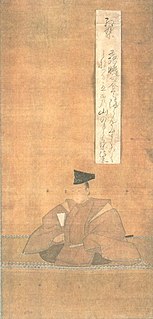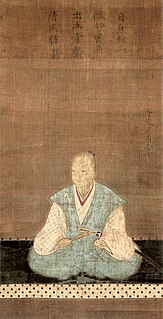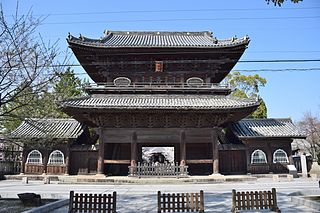The Rōjū (老中), usually translated as Elder, was one of the highest-ranking government posts under the Tokugawa shogunate of Edo period Japan. The term refers either to individual Elders, or to the Council of Elders as a whole; under the first two shōguns, there were only two Rōjū. The number was then increased to five, and later reduced to four. The Rōjū were appointed from the ranks of the fudai daimyōs with domains of between 25,000 and 50,000 koku.

Matsudaira Hirotada was the lord of Okazaki Castle in Mikawa province, Japan during the Sengoku Period of the 16th century.

Matsudaira Nobuyasu was the eldest son of Tokugawa Ieyasu. His tsūshō was Jirōsaburō (次郎三郎). He was called also "Okazaki Saburō", because he had become the lord of Okazaki Castle (岡崎城) in 1570. Because he was a son of Tokugawa Ieyasu, he is often referred to, retroactively, as Tokugawa Nobuyasu.

The Tokugawa clan was a powerful daimyō family of Japan. They nominally descended from Emperor Seiwa (850–880) and were a branch of the Minamoto clan by the Nitta clan. The early history of this clan remains a mystery. Members of the clan ruled Japan as shōguns from 1603 to 1867.

The Matsudaira clan was a Japanese samurai clan that claimed descent from the Minamoto clan. It originated in and took its name from Matsudaira village, in Mikawa Province. Over the course of its history, the clan produced many branches, most of which are also in Mikawa Province. In the 16th century, the main Matsudaira line experienced a meteoric rise to success during the direction of Matsudaira Motoyasu, who changed his name to Tokugawa Ieyasu and became the first Tokugawa shōgun. Ieyasu's line formed what became the Tokugawa clan; however, the branches retained the Matsudaira surname. Other branches were formed in the decades after Ieyasu, which bore the Matsudaira surname. Some of those branches were also of daimyō status.
Moriyama Domain was a feudal domain under the Tokugawa shogunate of Edo period Japan, located in southern Mutsu Province in what is now part of the modern-day city of Kōriyama, Fukushima. It was established by a cadet branch of the Tokugawa clan of Mito. A relatively small domain, it had a kokudaka of 20,000 koku.

Matsudaira Kiyoyasu was the 7th lord over the Matsudaira clan during the Sengoku period of Japan. Kiyoyasu was the grandfather of the unifier of Japan, Tokugawa Ieyasu. Kiyoyasu soon gained control of the whole of northern Mikawa Province after the Saigo clan surrendered following four generations of conflict. Okazaki Castle was also built as a monument to the Matsudaira's power.
![Matsudaira Nobunori [松平喜徳] daimyo of the late edo period; 10th lord of Aizu](https://upload.wikimedia.org/wikipedia/commons/thumb/1/1a/Matsudaira_Nobunori.jpg/237px-Matsudaira_Nobunori.jpg)
ViscountMatsudaira Nobunori was a Japanese samurai of the late Edo period who served as daimyō of Aizu Domain from 1868–69. Born the son of Tokugawa Nariaki of Mito, he was adopted by Matsudaira Katamori as successor. After a year of serving as daimyō, he resigned, allowing Katamori's birth son Keizaburō (Kataharu) to assume headship. Nobunori then became the head of the Matsudaira family of Matsukawa, and spent time studying abroad, in France.

Viscount Morio Matsudaira was an admiral in the Imperial Japanese Navy.
Matsudaira Iemoto was a Japanese samurai of the Sengoku through early Edo period. He is believed to have been the illegitimate son of Matsudaira Hirotada of Okazaki, and therefore the half-brother of Tokugawa Ieyasu. He known as Matsudaira Saburo Goro Iemoto.
![Matsudaira Tadamasa [松平忠昌] daimyo of the early Edo period; 3rd lord of Fukui](https://upload.wikimedia.org/wikipedia/commons/thumb/6/69/Matsudaira_Tadamasa.png/228px-Matsudaira_Tadamasa.png)
Matsudaira Tadamasa was an early to mid-Edo period Japanese samurai, and daimyō.
Matsudaira Yasuhide was a Japanese daimyō of the late Edo period, who ruled the Tanakura and then Kawagoe Domains. He served as gaikoku bugyō and rōjū in the Tokugawa administration.
Matsudaira Tadayori was a Sengoku period samurai who became a daimyō under the Tokugawa shogunate in early-Edo period Japan. He was also the founder of the Sakurai-branch of the Matsudaira clan.
Shigeyoshi is a masculine Japanese given name. Notable people with the name include:
Itoigawa Domain was a feudal domain under the Tokugawa shogunate of Edo period Japan. It is located in Echigo Province, Honshū. The domain was centered at Itoigawa Jin'ya, located in what is now part of the city of Itoigawa in Niigata Prefecture.
Kamehime was the eldest daughter of Tokugawa Ieyasu with his wife, Lady Tsukiyama. She married Okudaira Nobumasa, with him she had 4 sons and 1 daughter: Okudaira Iemasa (1577-1614) of Utsunomiya Domain, Matsudaira Ieharu (1579-1592), Matsudaira Tadaaki, Okudaira Tadamasa, daughter married Okubo Tadatsune of Kisai Domain. She is known to have took up her naginata to assist her husband and Torii Suneemon on the mission to cross the enemy army to request aid from Ieyasu in Okazaki and defended the castle in the Siege of Nagashino. After Ieyasu's death she had a larg part in the overthrow of Honda Masazumi whom she disliked.

Daiju-ji is a Buddhist temple located in Okazaki, Aichi. Built by Chikatada Matsudaira in 1475, Daiju-ji was the family temple of Matsudaira clan (松平氏) and Tokugawa clan (德川氏) which ruled Japan between 1600 and 1868. The Tahōtō of Daiju-ji, one of the Important Cultural Property of Japan was built by Kiyoyasu Matsudaira, grandfather of Ieyasu Tokugawa.





![Matsudaira Nobunori [松平喜徳] daimyo of the late edo period; 10th lord of Aizu](https://upload.wikimedia.org/wikipedia/commons/thumb/1/1a/Matsudaira_Nobunori.jpg/237px-Matsudaira_Nobunori.jpg)

![Matsudaira Tadamasa [松平忠昌] daimyo of the early Edo period; 3rd lord of Fukui](https://upload.wikimedia.org/wikipedia/commons/thumb/6/69/Matsudaira_Tadamasa.png/228px-Matsudaira_Tadamasa.png)
